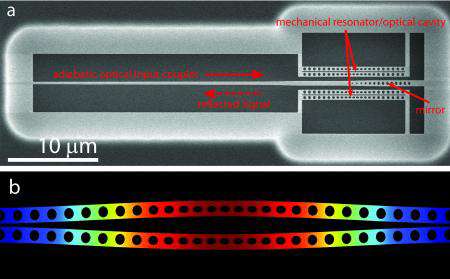Tiny sensors put the squeeze on light

Microelectromechanical systems, known as MEMS, are ubiquitous in modern military systems such as gyroscopes for navigation, tiny microphones for lightweight radios, and medical biosensors for assessing the wounded. Such applications benefit from the portability, low power, and low cost of MEMS devices. Although the use of MEMS sensors is now commonplace, they still operate many orders of magnitude below their theoretical performance limits. This is due to two obstacles: thermal fluctuations and random quantum fluctuations, a barrier known as the standard quantum limit.
DARPA's Optical Radiation Cooling and Heating in Integrated Devices (ORCHID) program seeks to overcome the latter obstacle to MEMS device performance. Overcoming the standard quantum limit, or Heisenberg limit, requires delicate engineering of the quantum state of the device. ORCHID is combining micro-optical and mechanical components into a single "optomechanical" device. Paired with novel measurement techniques, these devices can perform beyond the standard quantum limit.
In the latest program milestone, ORCHID researchers at the California Institute of Technology have reported a new method to generate specially-tailored "squeezed light" on a chip. Their work is detailed in the recent Nature paper "Squeezed light from a silicon micromechanical resonator".
"The Caltech team altered the typical noise properties of light using a deformable optical cavity to generate squeezed light with reduced amplitude fluctuations," said Jamil Abo-Shaeer, the DARPA program manager who led the ORCHID program. "The researchers cleverly reduce the amplitude noise of the light at the expense of another parameter (phase) not involved in the measurement. Overall, the total noise in the system is unchanged, it's just redirected away from a parameter researchers need to measure. And unlike previous tabletop demonstrations, this new scheme uses chip-scale, silicon-based technology, giving it the potential for practical use in deployable sensors."
Squeezed light has long been a focus for researchers seeking more precise measurements. For example, one thrust of DARPA's Quantum-Assisted Sensing and Readout (QuASAR) program is optomechanical accelerometers, where squeezed light could play an important role in boosting accelerometer sensitivity. QuASAR researchers at the University of Colorado, as described in a recent paper in Physical Review X, "Strong Optomechanical Squeezing of Light", produced squeezed light using an optomechanical architecture consisting of a millimeter-sized silicon-nitride membrane coupled to a Fabry-Perot optical cavity. Other QuASAR thrusts, including magnetic field sensing and time-keeping, could also achieve performance boosts by employing squeezing.
The squeezed light approach is just the latest breakthrough in a program that quickly transitions basic research to practical applications. Since its launch in 2010, ORCHID has also developed integrated optomechanical devices for low-phase-noise microwave oscillators, which are useful for a variety of DoD applications including secure communication, navigation and surveillance. ORCHID technologies have also benefitted optical signal processing for on-chip light delays, switches, efficient optical wavelength conversion, light storage and high-speed tunable optical filters.
Robert Lutwak, current ORCHID program manager, commented on the importance of this breakthrough for practical applications in position, navigation and timing. "Since the early development of MEMS fabrication technology, pioneered by DARPA in the 1990s, MEMS devices have grown to serve a critical role in both commercial and DoD navigation and sensing systems. The recent ORCHID results pave the way for a new generation of MEMS inertial sensors with many orders of magnitude superior performance to what is possible with today's technology."
Journal information: Nature , Physical Review X
Provided by DARPA




















